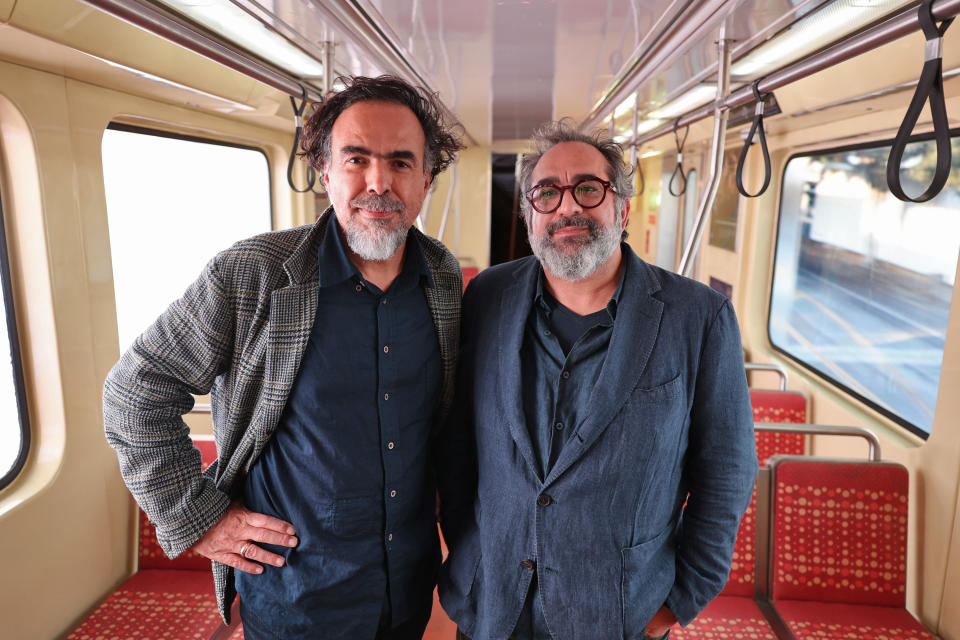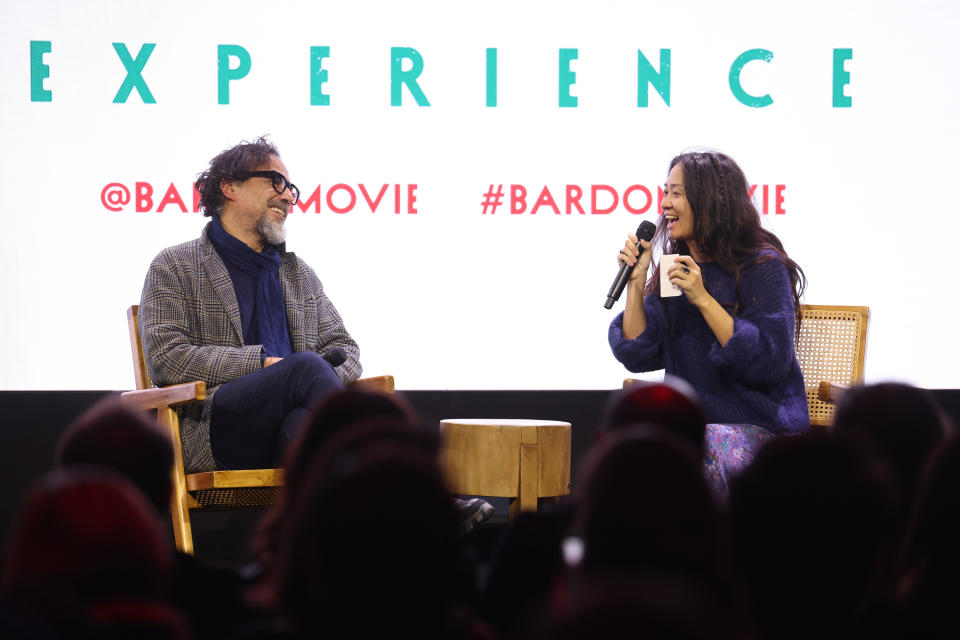‘Bardo’s Production Designer on Why He Flooded a Key Set and Other Takeaways From Netflix’s Artisans Showcase
- Oops!Something went wrong.Please try again later.
- Oops!Something went wrong.Please try again later.
- Oops!Something went wrong.Please try again later.

With the release of Alejandro G. Iñárritu’s “Bardo: False Chronicles of a Handful of Truths,” Netflix invited guests to experience the sights and sounds of the Academy Award-winning director’s most personal film.
Through a series of conversations, the audience learned more about the design and craft of the project and had the opportunity to view concept art, costumes, and pieces from the sets.
More from Variety
Ryan Murphy Explains Why He Didn't Reach Out to Jeffrey Dahmer's Father for Netflix Series
Netflix Lands 'My Hero Academia' Live-Action Movie, Adds 'Obi-Wan Kenobi' Writer Joby Harold
Daniel Giménez Cacho stars as Silverio Gama, a Mexican journalist and documentary filmmaker living in Los Angeles. Silverio finds himself on a surreal journey into memories and dreams when he returns to Mexico after many years away.
“Bardo, False Chronicles of a Handful of Truths” will stream globally on Netflix beginning December 16.
Cinematographer Darius Khondji agreed to work on the film without reading the script
Darius Khondji has worked on films from “Seven” to “Uncut Gems,” earning an Academy Award nomination for “Evita” in 1996. Sitting down with DP and moderator Erik Messerschmidt (“Mank”), Khondji says he met with Iñárritu three times to discuss the project and was ready to sign on before ever reading the script.
The Iranian-French cinematographer describes his initial meetings with the director as “deep” and “articulate.” He recalls early conversations in which Iñárritu, “was talking to me about his life in America and Mexico, and more and more I was drawn deeply into the film.”
When he finally read the script, he marveled at its complexity and beauty. Khondji says, “The script was, truthfully, one of the greatest or maybe the greatest script I’ve ever read. It was a book about life.”
‘Bardo’ is like an Old Hollywood Production
The planning and pre-production stage for “Bardo” took many months and, according to Khondji, Iñárritu had a very clear design in mind. One element that was decided early was to shoot the entire film in 65mm, an exciting challenge that provided opportunities for a crew of mixed nationalities to work together. “It was like an orchestra,” Khondji describes it.
Preparation is vital for a production like this and Khondji recalls, “Everything was prevised. We knew exactly where the camera was going to be. Some changes were made, but everything was prepared before.” Of course, there are always surprises once the cameras start rolling. “On the day,” he says, “you shoot it and there are things you realize the camera cannot do.”
Old Hollywood and Surrealist Artists were references for the overall look
Silverio’s story has a surrealist quality to it, and there were many early 20th-century films and artists that served as references to create the right look. Khondji describes the transparent quality of the air in Mexico and found himself drawn to the color photography of Vivian Maier for inspiration.
Khondji and Iñárritu also looked to the work of Belgian painter Paul Delvaux, Italian painter Giorgio de Chirico and Swedish filmmaker Roy Andersson. Classic films also helped when it came to finding the right rhythm for the camera work. Fellini’s “8 ½” and Fosse’s “All That Jazz” were particularly helpful.
“References are like friends around you,” Khondji explains. “They’re like spirits. You should never use them literally. You travel with them, they are with you.” Messerschmidt adds, “It’s a way to start a conversation, not to end it.”
Silverio’s apartment was flooded, drained, and then relocated 300km
One location that figures prominently into “Bardo” and main character Silverio’s experience is his Mexico City apartment. To bring the scene to life, production designer Eugenio Caballero built what he calls a “film box” in the studio. The set was designed to be fully contained, hiding wires and cameras.
For a key moment in the film, the apartment is flooded, and Caballero’s design allowed the set to be completely flooded for in-camera effects rather than CGI. The scene is complex and involves walls that open and close on hinges, pulleys, and other mechanisms. The set also included dams to divert water in specific directions.
After the flooding sequence was filmed, the entire set had to be drained and relocated from the studio in Mexico City and rebuilt in the desert of Baja California, 300km away. Caballeros says, “We had this flat land and the light was super special. I think it was it was very important for the film.”
The train in the film is based on the Santa Monica line

Another important set was the Santa Monica train, in which Silverio encounters another surprising sequence of events. According to Caballero, the entire train was built from scratch. They could not use an actual train because this set would also be flooded. The design was based on the actual Santa Monica train, although, he explains, “We tweaked it a little bit in terms of colors or in terms of where the windows should be to make it more friendly to shoot.”
They built the train on a platform of springs to simulate movement. Visitors to the Bardo Experience had the opportunity to board the train, which was brought up from Mexico for the event. It did, indeed, replicate the experience of riding on the LA metro, including simulated images outside the windows.
The right sound for falling bodies
At a certain point in Silverio’s dreamlike wandering, he encounters people who suddenly fall, lifeless, to the street. The falling bodies created very specific sounds and presented an interesting challenge for the sound team to find the right cadence and effect. The key was to find a sound that was slightly augmented and not too real, as re-recording mixer Jon Taylor shares.
The process involved determining the number of impact points as each person fell, as well as the volume of each drop. To make sure each falling person was included in the sound design, Iñárritu used a laser pointer on the stage to indicate individuals that needed more or less sound and at higher or lower volumes.
Taylor says, “It kept changing a little bit, to have what felt real and what was slightly unreal. And I think we ended up a little more on a slightly unreal side.”
A movie is made long before it is filmed

Two Academy Award-winning directors, Alejandro Iñárritu and Chloé Zhao (“Nomadland”) discussed the overall process of making movies. As Iñárritu describes it, “When you arrive to make a movie, you’re just executing the movie. It was made two or three years ago.” He likens it to a musician playing a concert after years of practicing many hours per day.
He does agree that there are things that can happen in the moment on the set and any film can make room for improvisation. “But,” he cautions, “you cannot rely all the time on that because it happens once every ten times and then nine times all the improvising goes to hell. Pre-production is very important.”
The future of cinema is an experience
When asked about the future of cinema, Iñárritu shares his main interest. “I want people to experience things,” he says. “There is no bad or good experience. It’s an experience. I’m trying to find a language or a grammatical way for me to get into people schemes and make them feel an experience through cinema. Maybe I fail, but even failing is better than to not attempt it.”
Best of Variety
Sign up for Variety’s Newsletter. For the latest news, follow us on Facebook, Twitter, and Instagram.

